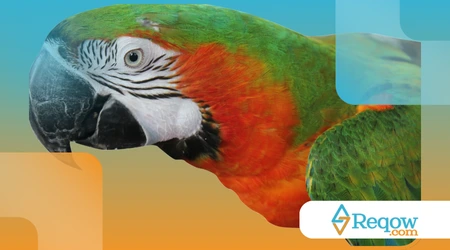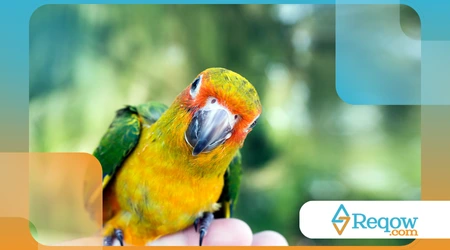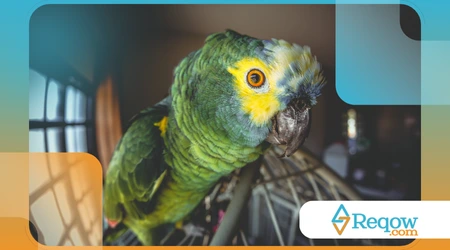Can parrots learn to recognize human emotions? Science answers

Parrots can learn to recognize human emotions. The idea that parrots can go beyond simple vocal imitation is fascinating.
Advertisements
Observers report behaviors that suggest a deeper understanding. Is this just a well-rehearsed trick or something more substantial?
It's a common mistake to view word repetition as mere imitation. Research suggests that vocalization can be linked to social and emotional contexts.
This suggests an underlying intelligence, not just rote repetition.
Consider the African grey parrot, known for its remarkable linguistic ability. They not only replicate sounds but also use them functionally.
Advertisements
This skill suggests a keen perception of the environment and its interactions.
Alex, the famous African grey parrot, demonstrated impressive cognitive abilities. He could identify colors, shapes, and even quantities.
His intelligence went far beyond mere mimicry.
This cognitive ability makes us question the limits of communication. Could this intelligence extend to reading emotional signals?
Many tutors believe so, based on their daily experiences.
The Nonverbal Language of Parrots
Just like us, parrots communicate in many ways. Their posture, the brightness of their eyes, and the way their feathers ruffle tell stories.
They are masters at expressing their mood without a single word.
A parrot that preens its feathers may be feeling fear or discomfort.
One with ruffled feathers and dilated pupils could indicate excitement or aggression. These are clear signs for those who know how to observe them.
Their visual perception is highly developed, and they capture nuances. A furrowed brow, a smile, or a sad expression don't go unnoticed.
They filter the visual world intensely.
Read more: 7 Interesting Facts About Cats' Sleep
Constant interaction with humans can enhance this perception. They become attuned to behavior patterns and daily routines. This creates a foundation for interpreting signals.
Imagine a mirror that reflects not only your image, but also your mood. Parrots, to a certain extent, work like this. They absorb and react to the emotional atmosphere of their environment.
Avian Empathy? The Interpretation of Human Emotions
The big question is whether this observation translates into emotional understanding. Does a parrot feel something similar when it sees a sad person?
Or do you just associate sadness with a specific behavior?
Some studies suggest that parrots can learn to recognize human emotions and even react to them.
Researcher Irene Pepperberg, famous for her work with Alex, observed behaviors that indicate this ability.
Alex, for example, could vocalize “I’m sorry” in moments of frustration for the researcher, suggesting an association.
This is not empathy in the complex human sense, but a form of correlation.
A parrot can associate a specific tone of voice or facial expression with a consequence. This helps it navigate the social environment.
They learn to associate emotional states with specific reactions. An angry owner can mean less interaction.
A happy owner, on the other hand, can mean more playtime and treats.
This is a form of adaptive intelligence, crucial for group survival. In their natural habitats, reading social cues is vital.
This same instinct can be applied to interacting with humans.
Even though “empathy” is a strong term, the responsiveness is remarkable.
They respond in ways that seem intentional and contextual. This is what most intrigues researchers and tutors.
The Irene Pepperberg Study and Parrot Cognition
One of the cornerstones of this discussion is the work of Dr. Irene Pepperberg. Her research with Alex opened doors to understanding the minds of parrots.
He demonstrated cognitive abilities previously unthinkable in birds.
Alex not only imitated words, but also understood them in context. He could form simple sentences to express desires.
This linguistic ability was indicative of complex cognitive processes.
See how important: Pets drinking too much water: normal behavior or red flag?
Dr. Pepperberg used an innovative teaching method, the "model/rival" approach. This allowed Alex to observe the interaction between two humans.
He learned by observing and trying to imitate correct behavior.
An example of this was Alex's ability to differentiate "which" from "how many." He could identify an object's color and its quantity.
This demonstrates an understanding of abstract concepts.
This robust cognitive foundation raises the possibility of emotional recognition. If Alex could categorize objects, why not emotions? The complexity of his brain is underestimated by many.
Dr. Irene Pepperberg's work with Alex is extensively documented in scientific papers and in her book, "Alex & Me."
A remarkable research published in 2007 in the Journal of Comparative Psychology by Pepperberg, IM Titled “Grey Parrot (Psittacus erithacus) as a recipient of human intentional action” discusses Alex’s ability to interact intentionally, suggesting a sophisticated level of social cognition.

The Avian Brain: A Learning Machine
Parrots' brains, though small, are incredibly dense with neurons. This neural density is comparable to that of primates. It's an efficient and powerful learning and processing machine.
The neural plasticity of these brains is a key factor. They can adapt and form new connections quickly. This enables the acquisition of complex skills and continuous learning.
The ability to associate sounds with meaning is proof of this. They create a mental dictionary that connects vocals to action or emotion. This is a form of advanced associative intelligence.
Their memory is also impressive, allowing them to retain information for long periods of time.
They remember people, places, and even past experiences. This memory is vital for recognizing emotional patterns.
This brain structure is the basis for complex cognition. It's not just imitation, but understanding that sets them apart. They are more than mere repeaters; they are thinkers.
Evolution has equipped them with the tools to thrive in social environments.
Communication is fundamental, and reading signals is an intrinsic part of that. It's a testament to the sophistication of avian life.
Parrots and the Mirror of Our Emotions: Cases and Analysis
Many owners share stories that reinforce this idea. They describe how their parrots react to joy or sadness.
These anecdotal observations are valuable, although they are not scientific proof.
A parrot may sing when its owner is happy, or become silent when sad. It may even try to "comfort" with caresses or words.
++ Pets and Vet Visits: How to Prepare Your Pet and Reduce Stress
These behaviors are often interpreted as emotional recognition.
Carla, a guardian of a Congo African Grey named Chico, says that whenever she feels anxious or stressed, Chico begins to chirp in a lower, softer tone, and occasionally repeats “calm down, calm down,” a term she uses for herself in these moments.
For Carla, this is a clear sign that parrots can learn to recognize human emotions, and he is trying to express comfort.
At a rescue bird shelter, an eclectus parrot named Percy was exhibiting peculiar behavior.
He would become agitated and vocalize loudly when he saw volunteers arguing. Conversely, when the environment was calm and the volunteers interacted amicably, Percy displayed more relaxed feathers and emitted soft, melodious calls.
This distinction in reaction suggests that he associated tones of voice and postures with specific emotional states.
Interpreting these behaviors is complex, however. It could be a result of conditioning, where the parrot associates sadness with silence.
Or true empathic understanding, which is harder to prove.
Careful observation and pattern analysis are crucial. It's important to distinguish between cause and correlation. But the consistency of these reports is hard to ignore.

Challenges and Future of Research
There's still much to be discovered about parrot cognition. The research is complex, requiring rigorous methods. How can we measure emotional understanding in a creature so different from us?
One of the biggest challenges is avoiding anthropomorphization. Attributing human emotions to animals can distort understanding. Maintaining scientific objectivity is essential.
Technology could play a crucial role in the future. Vocalization and behavior analysis tools could offer new insights. This will provide us with more concrete data.
The study of avian neuroscience is also advancing rapidly. Understanding the structure and function of parrot brains is vital. This will reveal the mechanisms underlying learning and cognition.
Continuing to research interspecies interactions is crucial. The more we understand, the better we can care for these remarkable beings. And the more we can learn about ourselves.
After all, the search for this answer leads us to question the nature of intelligence. It's an ongoing journey of discovery. The question isn't "if," but "how." parrots can learn to recognize human emotions.
Emotional Recognition: A Comparison Chart of Signs
| Observed Human Emotion | Common Parrot Responses | Suggested Interpretation |
| Joy/Happiness | Happy songs, whistles, positive vocalizations, head bobbing, relaxed feathers, dilated pupils. | Parrots associate joy with a safe and happy environment, possibly reflecting mood or seeking positive attention. |
| Sadness/Apathy | Silence, curled up posture, low vocalizations, little interaction, feathers slightly ruffled. | You may associate sadness with a less stimulating or worrying environment, or a change in your guardian's behavior. |
| Anger/Frustration | Loud screams, ruffled feathers, sudden movements, constricted pupils, pecking (in extreme cases). | Parrots perceive tension and stress and may react with fear, aggression, or by trying to appease/avoid conflict. |
| Fear/Anxiety | Shrunken posture, low or repetitive vocalizations, trembling, attempts to hide, feathers pressed tightly to the body. | The parrot detects tension in the environment and in its owner, reacting with its own signs of fear or apprehension. |
| Confidence/Relaxation | Relaxed feathers, soft vocalizations, seeking caresses, peaceful perching. | Recognizes a safe environment and a trustworthy person, feeling comfortable interacting and relaxing. |
An observational study, though not specifically focused on parrots but on animal intelligence and communication, estimates that over 70% of human communication is nonverbal.
If parrots are able to pick up on nuances of vocalization and posture, they are naturally equipped to detect a significant portion of our emotional signals, even if their interpretation differs from ours.
A Look into the Future of Interspecies Understanding
The journey to understand if parrots can learn to recognize human emotions is fascinating and continuous.
Anecdotal evidence is powerful, and science is beginning to unravel the mechanisms behind these interactions.
It's undeniable that these animals possess remarkable intelligence, capable of going far beyond mere imitation. The future promises us more discoveries.
Like a complex melody, where each note represents a subtle signal, parrots seem to orchestrate their responses.
They don't just hear music, they understand its rhythm and emotion. And why wouldn't they be able to decipher our emotions, if they're so adept at understanding the world around them?
Frequently Asked Questions
Do parrots feel empathy like humans?
Not exactly like humans. Parrots' "empathy" is more of an ability to associate human emotional cues with behaviors and outcomes.
They respond to these associations in a way that resembles empathy, but they don't necessarily feel the emotion in the same way we do.
How can I tell if my parrot is “reading” my emotions?
Observe your parrot's reactions to your different moods.
If he consistently changes his behavior (vocalization, posture, interaction) in response to your emotions, it's a strong indication that he's picking up on the signals.
Do all parrots have the same ability to recognize emotions?
No. Ability can vary between species and even between individuals. African grey parrots, for example, are generally considered more adept at communication and cognition.
Socialization and environment also play a crucial role.
Does the way I interact with my parrot affect its ability to recognize emotions?
Yes, completely. Consistent, patient, and enriching interaction strengthens the bond.
This creates an environment where the parrot can learn and trust, making it easier to observe and respond to your emotional signals.
Is there ongoing research on this topic?
Yes, research into animal cognition, especially in birds like parrots, is an active field. Neurologists and ethologists continue to explore the cognitive and emotional capabilities of these animals, using new technologies and methodologies to gain deeper insights.
